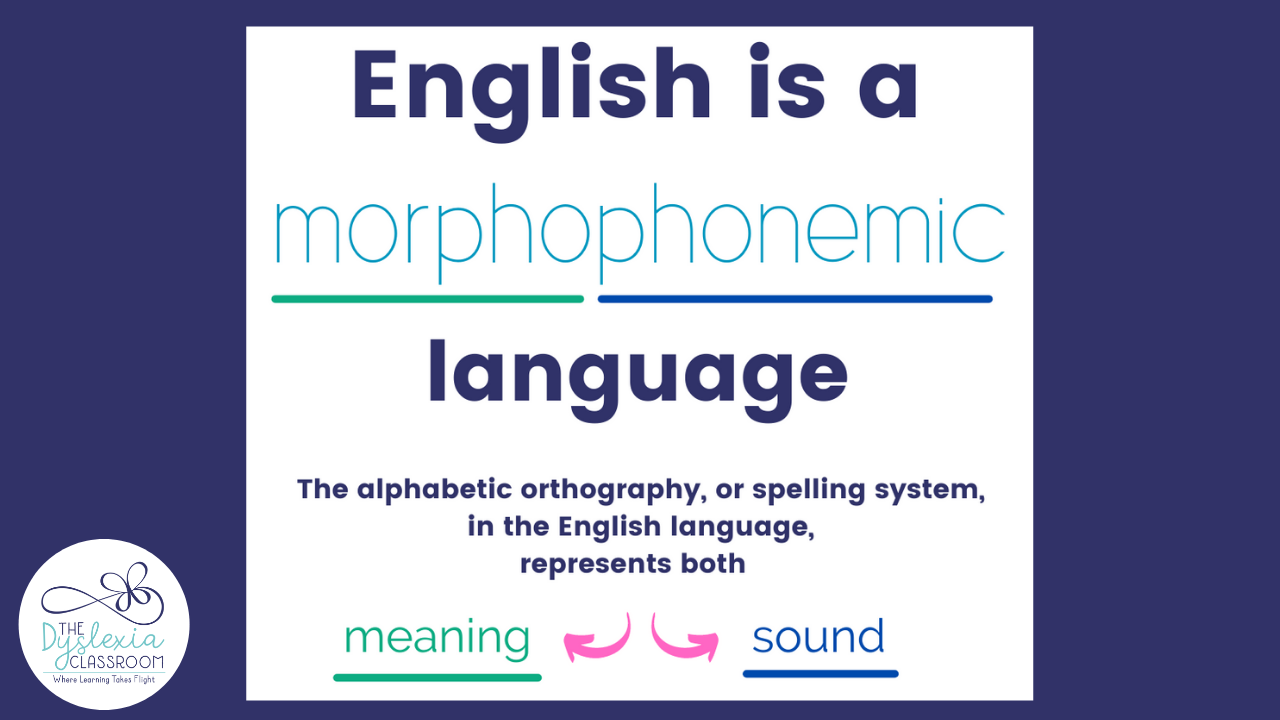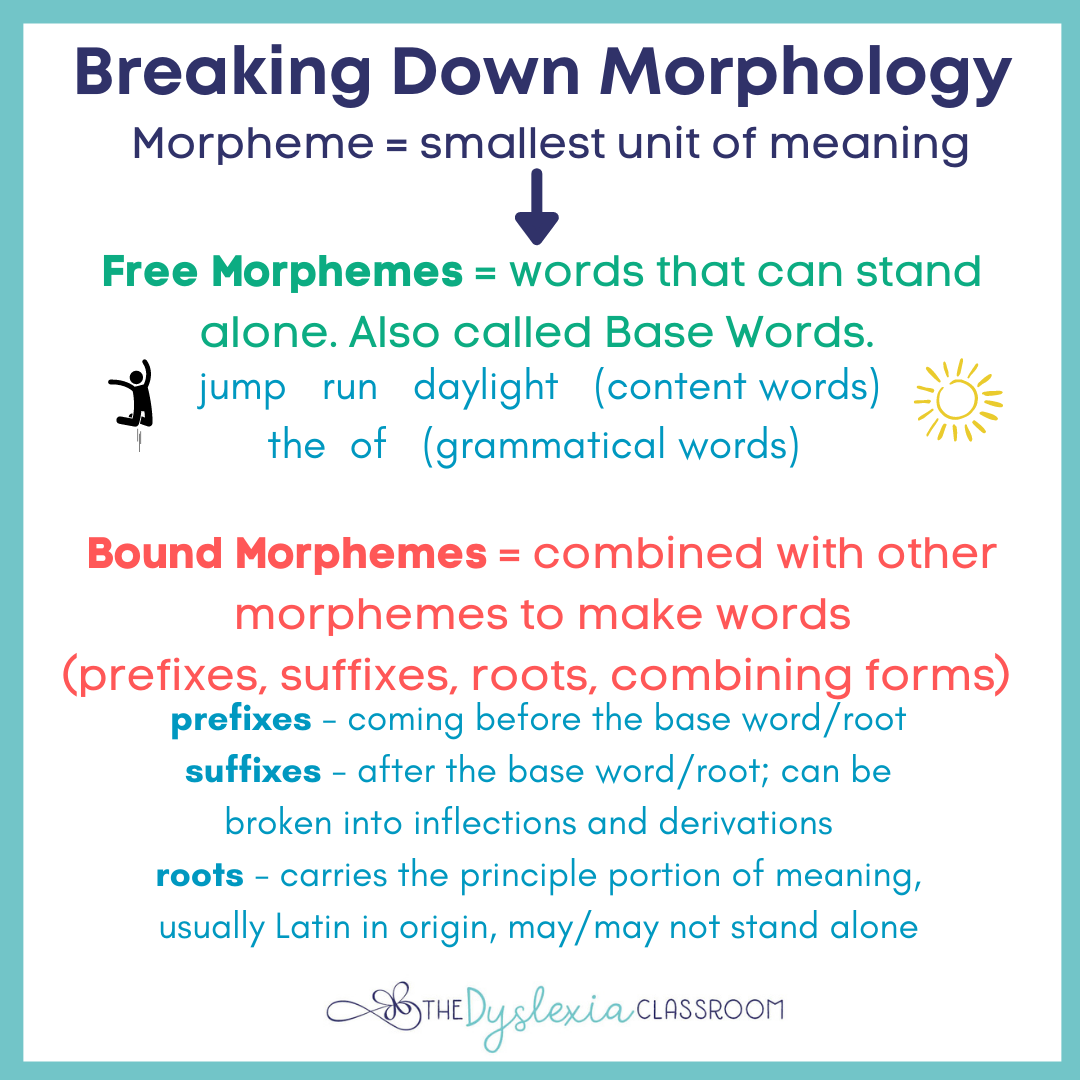How to Make Morphology Instruction Multisensory

From the beginning, we want students to understand that words carry meaning, and morphology is a great way to help students deepen their understanding of language. We don't have to wait for this instruction to take place. Instead, we can embed morphology instruction into our lessons and help students with this right from the start.
What is Morphology?
Morphology instruction, the study of words and how they are formed and used, is one of the elements of structured literacy. When we look at language through the lens of units of meaning within words, that is part of morphology. Dr. Louisa Moats notes, "Knowing morphemes enhances reading, vocabulary, and spelling." (Moats, 2000).
When we work with morphemes, we work with the smallest unit of meaning that exists within our language. Morphemes can be single letters, or units of letters, that carry meaning and may or may not stand alone.
The English language is considered a deep orthography. Morphology includes prefixes, suffixes, free morphemes, bound morphemes, roots, and combining forms. The English writing system is morphophonemic or represents meaningful parts (morphemes) and speech sounds (phonemic).

There are a lot of terms associated with morphology. This image ⬆️ provides a quick reference for some of the terms. If you want a deeper look at these, you can read the blog post HERE for a breakdown of morphology examples in spelling dictation.
Why Does It Matter in Reading Instruction?
Research shows that students who received morphological awareness instruction "significantly increased comprehension and spelling of morphologically complex words in fourth-and-fifth grade children with dyslexia" (Arnbak & Elbro, 1996/2000).
There is so much to uncover with our students; it's fascinating! When working with my dyslexic learners, morphology is built into our scope and sequence, even at an early stage.
Early instruction with morphology can begin in the younger grades with inflectional suffixes. These suffixes, such as -ed, -s, -ing, -es, -er, and -est do not change the part of speech of the word when added. Morphology work connects to spelling conventions, meaning, and pronunciation, so we can't wait to introduce this concept!
How Do We Introduce Morphology to Students?
Make it multisensory!
Multisensory instruction, where we engage more than one sense simultaneously, is a perfect way to work with morphology instruction.
Our morphology instruction looks at the smallest units of meaning, beginning with base words and common prefixes and suffixes (affixes), and builds from there. One of the easiest ways to teach morphology to students is to begin with the concept of a base word.
A base word, at the core, is the simplest form of an English word. We can add prefixes and suffixes (affixes) to the base word to change its meaning or usage. When any prefixes or suffixes are removed, the base word remains a word that can stand alone.
Tips for Making this Concept Multi-Sensory

- Use sticky notes. I find that sticky notes make a perfect tool for teaching morphology. They are easy to manipulate and allow students to see how the prefix or suffix is ADDED to the base word to create a new word. Some ways that you can differentiate instruction with this strategy: have students read the base word first, then add the affix (prefix/suffix) and read the new word; begin with the derivative (new word) and have students pull apart the base word from the affix.
After explicit instruction in the prefix re-, the student read the base words on the page. Then the student created new words by adding the prefix to the base word. The sticky note was easily moved in front of the base word to manipulate the new word. In the photo👆, you can see that the student has added the prefix to make new words. So easy and effective!

- Use blocks or Legos®️ to build new words. My students love to manipulate the prefixes and suffixes with blocks or Legos®️. I found some colorful wooden blocks at a local consignment shop and immediately knew they would be perfect for morphology work! I added affixes to the blocks and created index cards with base words. I have these prepped for each lesson and use this as my multi-sensory practice for introducing the concept. It is an incredibly powerful approach for my students and one that I have used consistently over the last ten years. I find that explicitly teaching morphology through hands-on manipulatives speeds up our transfer to reading and spelling applications. Plus, who doesn't like playing with blocks during reading time! (Note-you can also use Jenga®️ blocks, Lego®️ or Duplo®️ blocks, or even wooden tiles)

- Coding Strategies. We want our students to transition to reading text as quickly as possible but with the necessary support to gradually release responsibility. You can read about this HERE. Coding is a strategy that allows students who are learning to read, who have dyslexia, or who may be struggling to have a clear system for decoding unknown words. They connect their learning of syllable types, sound-letter, and morphology by underlining, circling, or noting parts of words using diacritical markings, like those found in the dictionary. I have my students box the suffix and prefix for morphology work and then move to the base word. This strategy can be carried throughout all multisyllabic word reading and work with Latin roots and Greek combining forms.

- Include decodable text. We know that in order to become proficient at something we need ample opportunities to practice. Practice makes permanent! This is something that I come back to often as I reflect on my lessons. Am I providing enough practice for my students to solidify their learning to move us forward? Including decodable text that aligns with our morphology work is key. Here, my students can apply their coding strategies. We can layer in the hands-on manipulatives when needed. They can build their skills as we move from individual word reading to sentence reading to more extensive text reading. In this picture, you can see the student applying the sticky notes, blocks, and coding. Students begin to see these as "tools" that assist them in reading unknown words, and we will gradually release our use of them while always keeping them in our reading toolbox to access when needed.

- Build words with paper parts. Having students build words through the lens of morphology is a perfect strategy for working with multisyllabic words and meanings. This is especially helpful for students working with Latin roots and Greek combining forms. Students must think about the meaningful word part in which they are "growing" new words from the root by combining them with other roots, prefixes, and suffixes. Word study approached through this lens is powerful for multiple reasons: from understanding words on a higher level to seeing how our pronunciation may shift, how spellings remain, how meanings may shift, and how grammatically they can shift as well. It is a deep dive into our language and highlights the morphophonemic aspects. It really can be fun!
All these multi-sensory strategies and scaffolds allow the student to:
- identify, code, and read the base word.
- see how the prefix is ADDED to the base word.
- read the derivative (new word).
- use the new word orally in a sentence.
- apply the strategy and knowledge within decodable text.
- take home the sheet for additional practice.
I have found that breaking this down helps students understand the meaning and function of prefixes and suffixes. In addition, using a multisensory approach allows students to practice taught skills in a way that engages two or more of the senses simultaneously - and it's fun!
Multisensory instruction doesn't have to be fancy or expensive to be effective. The magic is in the explicit and systematic instruction that builds upon skills and sets students up for success. What are some ways that you embed morphology instruction into your lessons?
Remember to help your students right from the start in understanding that words carry meaning. These multi-sensory strategies are an easy way to help students deepen their understanding of language.

This information is the intellectual property of @2016 The Dyslexia Classroom. Do not use or repurpose without expressed permission from The Dyslexia Classroom. Please give The Dyslexia Classroom an attribution if you use, reference, or quote/paraphrase copyrighted materials. This includes but is not limited to blogs, social media, and resources.



